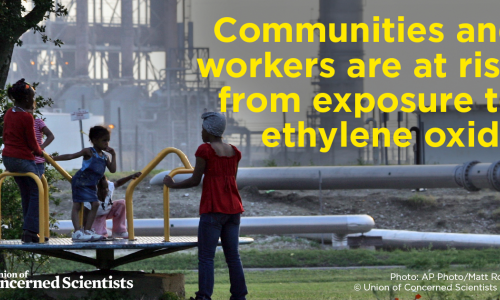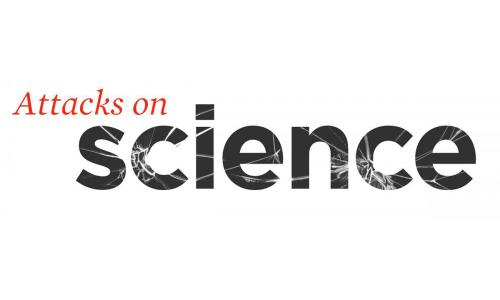Ethylene oxide (EtO) is a flammable, colorless gas used to sterilize medical equipment and other plastics that are sensitive to heat or moisture. And it is a building-block chemical used to make other chemicals, including antifreeze and some plastics. It's also a health threat to workers and communities.
The US Food & Drug Administration (FDA) estimates that EtO is used to sterilize about half of all medical equipment in the country, including bandages, sutures, and stents. Workers in facilities that produce and use EtO and people living near facilities that release it into the atmosphere are at risk of unsafe exposures even when the facilities are using the best available technologies to handle and contain it.
What are the health effects of exposure to EtO?
The US Environmental Protection Agency (EPA), the National Toxicology Program, and the International Association of Research on Cancer classify EtO as a carcinogen, meaning it is a substance that can cause certain cancers.
Chronic exposure to EtO through inhalation is associated with the development of cancers of the white blood cells, such as non-Hodgkin lymphoma, myeloma, and lymphocytic leukemia. Studies have also shown a relationship between EtO exposure and breast cancer in women. Also, because EtO is mutagenic—meaning it can change a cell's DNA—children may be especially susceptible to its cancer-causing effects.
Who is at most risk from EtO exposure?
In 2016, the EPA's Integrated Risk Information System (IRIS) classified ethylene oxide as carcinogenic to humans via exposures from inhaling the gas. This resulted in changes to the National Air Toxics Assessment, which revealed that more than 100 communities across the United States are exposed to concentrations of three chemicals, including ethylene oxide, above the level the EPA deems safe.
The EPA's National Air Toxics Assessment was developed as a screening tool for state, local, and tribal air agencies to identify which pollutants, emission sources, and places may require additional investigation to better understand possible risks to public health from air pollution. Long-term exposure to ethylene oxide is a significant contributor to higher cancer rates in some of the areas adjacent to EtO-emitting facilities, and disproportionately harms communities of color and low-income communities living near the fenceline of heavy industrial polluters.
It's important to note that fenceline communities are dealing not only with health effects from EtO but from the cumulative exposure to a variety of other hazardous chemicals and stressors resulting from a legacy of systemically racist policies.
According to the EPA's Office of the Inspector General (OIG), the census tracts nearest 14 of the 22 ethylene oxide-emitting facilities contributing to unacceptable cancer risks are made up of majority people of color and/or low-income households. One such community, St. John the Baptist Parish in Louisiana, has airborne concentrations of ethylene oxide and the potent carcinogen chloroprene with a cancer risk more than 200 times greater than EPA's "acceptable" levels.
In 2022, EPA also published a list of 23 sterilization facilities in U.S. states and Puerto Rico with ethylene oxide emissions that are contributing to elevated cancer risks nearby communities. EPA’s analysis did not include other exposures or stressors that can also contribute to cancer risks. In 2023, UCS published a report that affirmed and expanded on EPA’s research, finding that people of color and Spanish language speakers, in particular, are disproportionately at risk of ethylene oxide exposure from sterilization facilities. As shown in an interactive map, the UCS analysis found that more that more than 14 million people live, and more than 10,000 schools and childcare centers are located, within five miles of more than 100 facilities that emit ethylene oxide.
While ethylene oxide causes harm to people's health over decades, evidence suggests people are already being harmed. Near a sterilization facility in Willowbrook, IL, the Illinois Department of Health conducted air monitoring and found that rates of Hodgkin's lymphoma among women in the nearby community were nearly 90 percent higher than those in the county and state. Another study of communities living near another sterilization facility in Laredo, Texas found statistically significantly higher rates of acute lymphocytic leukemia and breast cancer compared to state averages.
Most fenceline communities do not have access to this type of information. Without real-time fenceline monitoring near these facilities, communities lack access to information about the exposures and health risks they face. The EPA has failed to communicate the high risks faced by community members living, working, and attending school near EtO-emitting facilities.
A 2020 EPA OIG report found that that the EPA had not reached out to 65 percent (16 of 25) of high-risk facilities identified as contributing to unacceptably high cancer risks—many of which are located in communities of color and low-income communities. The EPA must act to protect communities from exposure and give them the information they need to advocate for change.
How is the federal government responding to this public health threat?
Legal action, as well as pressure and input from an engaged public including local residents and community groups, scientists, and technical experts, along with nonprofits and coalitions working on this issue, has led the EPA to take action to protect the public.
In response to the high cancer risk posed to communities near EtO-emitting facilities, the EPA proposed changes to its Miscellaneous Organic Chemical Manufacturing (MON) rule in 2019, regulating toxic emissions for about 200 chemical plants that produce solvents, plastics, and pesticides across the country, and emit ethylene oxide, among other pollutants. MON facilities are especially concentrated in EPA's Region 6 in Texas and Louisiana, and disproportionately affect communities of color and low-income communities.
EPA's final rule, issued in 2020, would require technological fixes to reduce EtO emissions but would continue to allow periodic, uncontrolled releases of chemical pollution and fugitive emissions into communities without monitoring. These continued emissions would leave people exposed to cancer risks at twice the level the EPA considers acceptable under the Clean Air Act. After the rule was issued, UCS joined 10 community, scientist, environmental, and environmental justice groups by Earthjustice on a petition for its reconsideration. In January 2022, EPA issued a proposed rule in reconsideration of the MON rule, which UCS provided comments on. In December 2022, EPA affirmed its decision to use the science-based cancer risk value for ethylene oxide in finalizing its reconsideration of the MON rule. While this is a step forward, the MON rule still fails to require fenceline monitoring and other protections requested by affected communities, and may be updated in the future. EPA is also preparing to update standards for commercial sterilization facilities that use ethylene oxide to sterilize medical equipment and dried food products, like spices. A draft rule to update ethylene oxide standards for commercial sterilization facilities is expected by May 2023. During those processes, public comments will be accepted, and all substantive comments must be considered by the agency in their rulemaking.
The Food and Drug Administration (FDA) has also acknowledged that the agency has a role to play in identifying alternatives to EtO for sterilizing medical equipment. In 2019, it announced two innovation challenges in which FDA would work closely with companies to identify alternative approaches to EtO use that are safe and effective and the development of strategies to reduce emissions from the EtO sterilization process. However, recent updates from FDA indicate that the agency is focusing more on decreasing EtO use rather than phasing out its use altogether.
What else should be done to protect people from EtO?
Commercial sterilizers and MON facilities are just two of several types of facilities that emit ethylene oxide. The EPA urgently needs to act to update its emissions standards and residual risk reviews for all facilities emitting ethylene oxide. To do this, it must:
- Remove loopholes that allow periodic, uncontrolled emissions from industry processes, which continue to be a major problem.
- Increase penalties for EtO-emitting facilities that continuously fail to comply with Clean Air Act standards. Corporations should no longer be able to treat penalties as a normal cost of doing business.
- Implement and enforce EtO monitoring around the fencelines of all commercial sterilizers, MON facilities, and all other source categories of EtO emissions. Communities need and deserve strong protections. This starts with thorough data collection regarding EtO levels in fenceline communities and making this information publicly accessible and available in real time.
- Reach out to communities affected by EtO emissions, particularly facility workers, people near the highest-risk facilities, and people living with cumulative air pollution exposures in fenceline and hotspot communities. Communities must have opportunities to directly discuss their concerns with the EPA and to inform agency decisionmaking about facilities that directly affect their health. Furthermore, public databases like ECHO must be more accessible and easier to navigate for people who want to learn about the facilities and noncompliance in their communities.
- Ensure language access by providing appropriate materials and resources on the commercial sterilizer and forthcoming rulemaking processes in both English and other community-appropriate languages. Given the high concentration of facilities in Spanish-speaking communities, materials and interpretation in Spanish is critical.
- Work toward requiring a complete phaseout of EtO. Less toxic alternatives to EtO are available (Shahbandar 2018). The EPA should continue working to phase out EtO at all commercial sterilizers. Moreover, the Food and Drug Administration, which regulates medical devices and is working to identify alternatives to EtO for sterilization, must collaborate with the EPA (FDA, n.d.).
- Consider cumulative impacts and protect overburdened communities. Communities can be exposed to EtO from multiple sources, other sources of toxic pollution, and social stressors that can increase the risk of developing cancer and other adverse health outcomes. The EPA and other agencies should use a cumulative impacts framework to better understand the full effects of air toxics on people's health and safety. The agencies should implement safeguards that mitigate these effects and alleviate harm to disproportionately impacted communities.
- Alleviate chemical hazards to fenceline communities, including by strengthening the Risk Management Program (RMP), which covers some facilities that use and emit EtO, and EPA and Congress should align with the policy goals outlined in the Louisville Charter for Safer Chemicals (Coming Clean 2021).
- Congress should enact legislation, such as the Environmental Justice for All Act, that explicitly advances measures to protect fenceline communities, accounts for cumulative impacts, and requires fenceline monitoring (NRC, n.d.).
No one's ability to breathe clean air should depend on their race, income, or language. Everyone deserves clean air and environmental standards that protect their health and safety. The EPA must listen to the communities exposed to EtO--and to its own science showing the dangers. The problem is clear, the danger is real, and the agency must act now to adopt rules that strengthen controls of EtO emissions at commercial sterilizers and all other EtO-emitting facilities.
More from UCS on EtO
- UCS online resource: "Ethylene Oxide: What You Can Do"
- UCS report: “Invisible Threat, Inequitable Impact: Communities Impacted by Cancer-Causing Ethylene Oxide Pollution” and interactive StoryMap
- UCS blog post: “What is Ethylene Oxide? Answers to Your Questions about the Cancer-Causing Chemical?”
- UCS blog post: "EPA Rejects Industry Attempt to Downplay Ethylene Oxide Harms"
- UCS blog post: "EPA Needs to Trust its own Scientists"
- UCS blog post: "EPA Must Keep Communities Safe from Ethylene Oxide Cancer Risks"
- UCS blog post: "Watchdog Report Reveals a Failure to Talk to Communities with Higher Ethylene Oxide Health Risks"
- UCS blog post: "Responding to COVID-19 Doesn't-Have to Mean Sacrificing Frontline Communities"
- UCS online resource: "Official Blocked Attempts to Inform Communities about Cancer-Causing Gas"




